
Trimborn Farm is a Victorian era estate located in Greendale, Wisconsin and owned by Milwaukee County. Spanning 7.5 acres and nine buildings, it is listed on the National Register of Historic Places. The farm is also a State Historic Site and designated Milwaukee County Landmark.

The American System-Built Homes were modest houses designed by architect Frank Lloyd Wright. They were developed between 1912 and 1916 to fulfill his interest in affordable housing. Wright was devoted to the idea of providing beautiful yet affordable homes to the public. His firm produced over 960 drawings for the project, the largest number of drawings for any project in the Wright archives. The designs were standardized, and customers could choose from seven models. Because of this standardization, the lumber could be precut at the factory, thereby cutting down on both waste and the amount of skilled labor needed for construction. The buildings are often termed prefabricated homes, but they were not, since no parts of the homes were constructed off-site. The lumber was cut at the factory, packaged along with all other components, and delivered to the work site for construction. Some are located in a federal historic district in Milwaukee, Wisconsin, and others have been designated Chicago Landmarks in Chicago, Illinois.
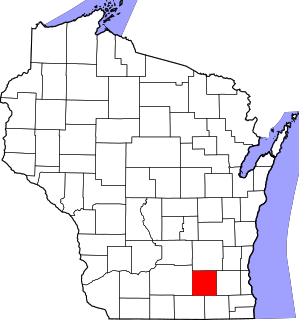
This is a list of the National Register of Historic Places listings in Jefferson County, Wisconsin. It is intended to provide a comprehensive listing of entries in the National Register of Historic Places that are located in Jefferson County, Wisconsin. The locations of National Register properties for which the latitude and longitude coordinates are included below may be seen in a map.

Trinity Episcopal Church is an historic Episcopal church located in Oshkosh, Wisconsin. The only Episcopal church in Oshkosh, Trinity is in the Diocese of Fond du Lac. The congregation first met in 1850, organizing as Trinity Episcopal Church in 1854. The current church building, which was constructed in 1887, is an example of Richardsonian Romanesque architecture. It was added to the National Register of Historic Places in 1974.

The Society of the Congregational Church of Great Barrington is an historic church building and parish house located at 241 and 251 Main Street in Great Barrington, Massachusetts. It is the fourth church of a congregation whose first meetings were held in 1743.
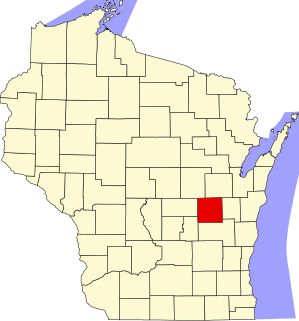
This is a list of the National Register of Historic Places listings in Winnebago County, Wisconsin.

The Richard Guenther House in Oshkosh, Wisconsin, United States, is a large, fine Queen Anne house designed by Waters and built by Jacob Rheiner in 1888 for Richard W. Guenther. Guenther was a Prussian immigrant who owned a drug store in Oshkosh, became Wisconsin state treasurer, US Congressman, and consul to Mexico City, Frankurt, and Cape Town. From 1906 to 1913 the large house hosted Dr. M. E. Corbett's new Lakeside Sanitorium and Training School for Nurses, the first hospital in Oshkosh, which later evolved into Mercy Medical Center.

This is a list of the National Register of Historic Places listings in Fillmore County, Minnesota. It is intended to be a complete list of the properties and districts on the National Register of Historic Places in Fillmore County, Minnesota, United States. The locations of National Register properties and districts for which the latitude and longitude coordinates are included below, may be seen in an online map.

The Episcopal Church of the Saviour, also known as Memorial Episcopal Church, is a parish church in the Episcopal Diocese of Iowa. The church is located in Clermont, Iowa, United States. The church building, along with the statue of David Henderson, was listed on the National Register of Historic Places in 2000.
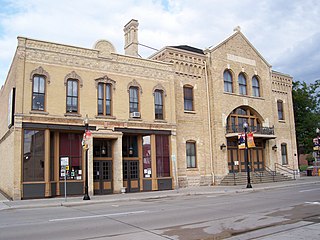
The Grand Opera House, commonly referred as The Grand, is a historic opera house located at the corner of High Avenue and Market Street in Oshkosh, Wisconsin, United States. It was built in 1883, designed by William Waters, a local architect, and underwent a major refurbishing in 2009–2010 at an expense of two million dollars. The roof trusses were reinforced, the ceilings were replaced, and a large chandelier was repaired. Additionally a new "Grand Lounge" was added for improved audience services and to smaller events. Today, the opera house seats 550, hosts nearly 100 public performances a year including community and repertory theater, symphony orchestra, corporate meetings and weddings; it is operated by the non-profit Oshkosh Opera House foundation. The theater was listed on the National Register of Historic Places in 1974.
Henry Wildhagen was one of northern Wisconsin’s best-known architects at the turn of the 20th century.
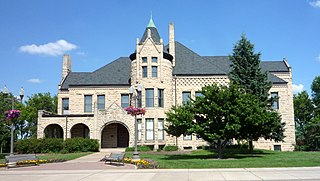
The Louis Smith Tainter House is a historic building in Menomonie, Wisconsin, United States. The building was built in 1889 by architect Harvey Ellis; it was funded by Andrew Tainter, a partner in Knapp, Stout & Co., as a home and wedding gift for his son Louis Smith Tainter. The building was built out of locally quarried sandstone in the Richardsonian Romanesque style. Paul Wilson, the son of lumberman William Wilson, owned the house after Tainter; in 1940, Dunn County repossessed the property for back taxes. The Stout Institute bought the property from the county and converted it to a women's dormitory named Eichelberger Hall for the University of Wisconsin–Stout in 1945. The house was later converted to offices for the university and now houses the Stout University Foundation and the Stout Alumni Association. On July 18, 1974, the house was added to the National Register of Historic Places.

Algoma Boulevard Methodist Church is a historic Methodist church at 1174 Algoma Boulevard in Oshkosh, Wisconsin, United States. The congregation was founded in 1870. Its building was built in 1890 and it was added to the National Register of Historic Places in 1974.

South Hall is located on the campus of what is now the University of Wisconsin-River Falls. It was added to the National Register of Historic Places in 1976.

The Jessie Jack Hooper House is located in Oshkosh, Wisconsin.

The Oviatt House is located in Oshkosh, Wisconsin.

The Brooklyn No. 4 Fire House is located in Oshkosh, Wisconsin.
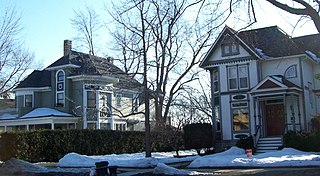
The Algoma Boulevard Historic District is located in Oshkosh, Wisconsin.






















